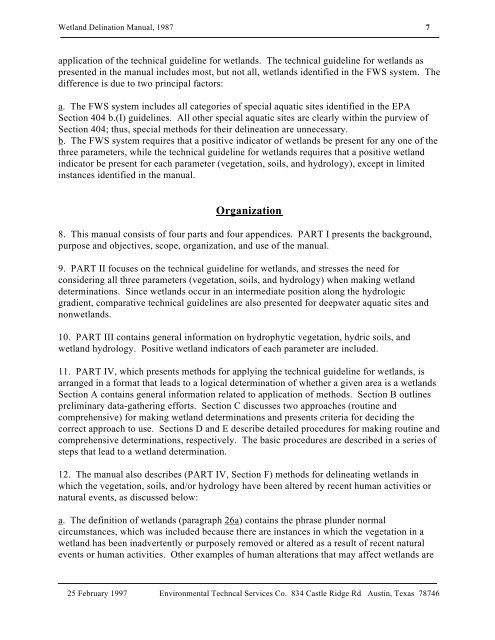1987 Wetland Delineation Manual - The Wetlands Regulation Center
1987 Wetland Delineation Manual - The Wetlands Regulation Center
1987 Wetland Delineation Manual - The Wetlands Regulation Center
Create successful ePaper yourself
Turn your PDF publications into a flip-book with our unique Google optimized e-Paper software.
<strong>Wetland</strong> Delination <strong>Manual</strong>, <strong>1987</strong> 7<br />
application of the technical guideline for wetlands. <strong>The</strong> technical guideline for wetlands as<br />
presented in the manual includes most, but not all, wetlands identified in the FWS system. <strong>The</strong><br />
difference is due to two principal factors:<br />
a. <strong>The</strong> FWS system includes all categories of special aquatic sites identified in the EPA<br />
Section 404 b.(I) guidelines. All other special aquatic sites are clearly within the purview of<br />
Section 404; thus, special methods for their delineation are unnecessary.<br />
b. <strong>The</strong> FWS system requires that a positive indicator of wetlands be present for any one of the<br />
three parameters, while the technical guideline for wetlands requires that a positive wetland<br />
indicator be present for each parameter (vegetation, soils, and hydrology), except in limited<br />
instances identified in the manual.<br />
Organization<br />
8. This manual consists of four parts and four appendices. PART I presents the background,<br />
purpose and objectives, scope, organization, and use of the manual.<br />
9. PART II focuses on the technical guideline for wetlands, and stresses the need for<br />
considering all three parameters (vegetation, soils, and hydrology) when making wetland<br />
determinations. Since wetlands occur in an intermediate position along the hydrologic<br />
gradient, comparative technical guidelines are also presented for deepwater aquatic sites and<br />
nonwetlands.<br />
10. PART III contains general information on hydrophytic vegetation, hydric soils, and<br />
wetland hydrology. Positive wetland indicators of each parameter are included.<br />
11. PART IV, which presents methods for applying the technical guideline for wetlands, is<br />
arranged in a format that leads to a logical determination of whether a given area is a wetlands<br />
Section A contains general information related to application of methods. Section B outlines<br />
preliminary data-gathering efforts. Section C discusses two approaches (routine and<br />
comprehensive) for making wetland determinations and presents criteria for deciding the<br />
correct approach to use. Sections D and E describe detailed procedures for making routine and<br />
comprehensive determinations, respectively. <strong>The</strong> basic procedures are described in a series of<br />
steps that lead to a wetland determination.<br />
12. <strong>The</strong> manual also describes (PART IV, Section F) methods for delineating wetlands in<br />
which the vegetation, soils, and/or hydrology have been altered by recent human activities or<br />
natural events, as discussed below:<br />
a. <strong>The</strong> definition of wetlands (paragraph 26a) contains the phrase plunder normal<br />
circumstances, which was included because there are instances in which the vegetation in a<br />
wetland has been inadvertently or purposely removed or altered as a result of recent natural<br />
events or human activities. Other examples of human alterations that may affect wetlands are<br />
25 February 1997 Environmental Techncal Services Co. 834 Castle Ridge Rd Austin, Texas 78746


